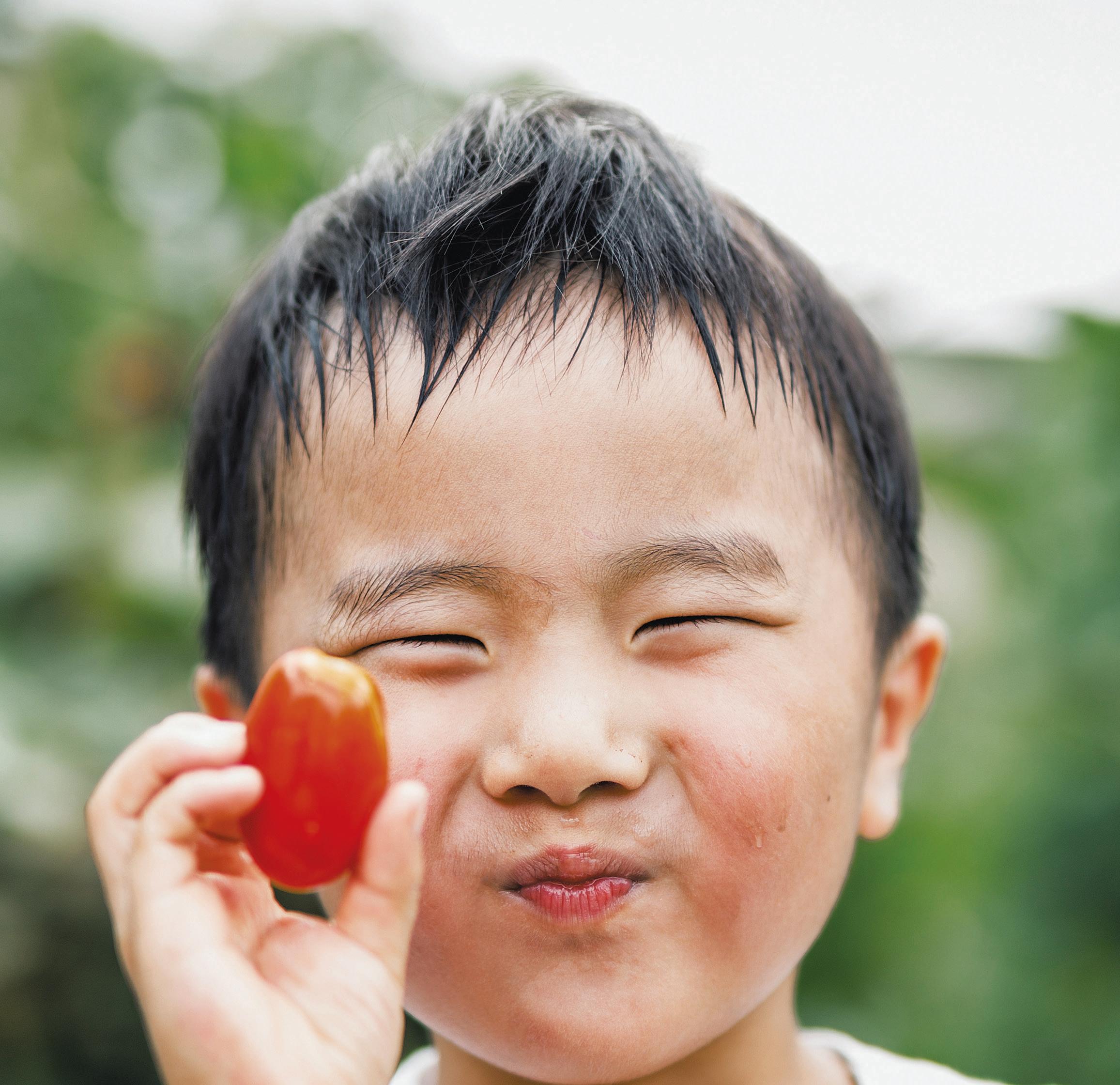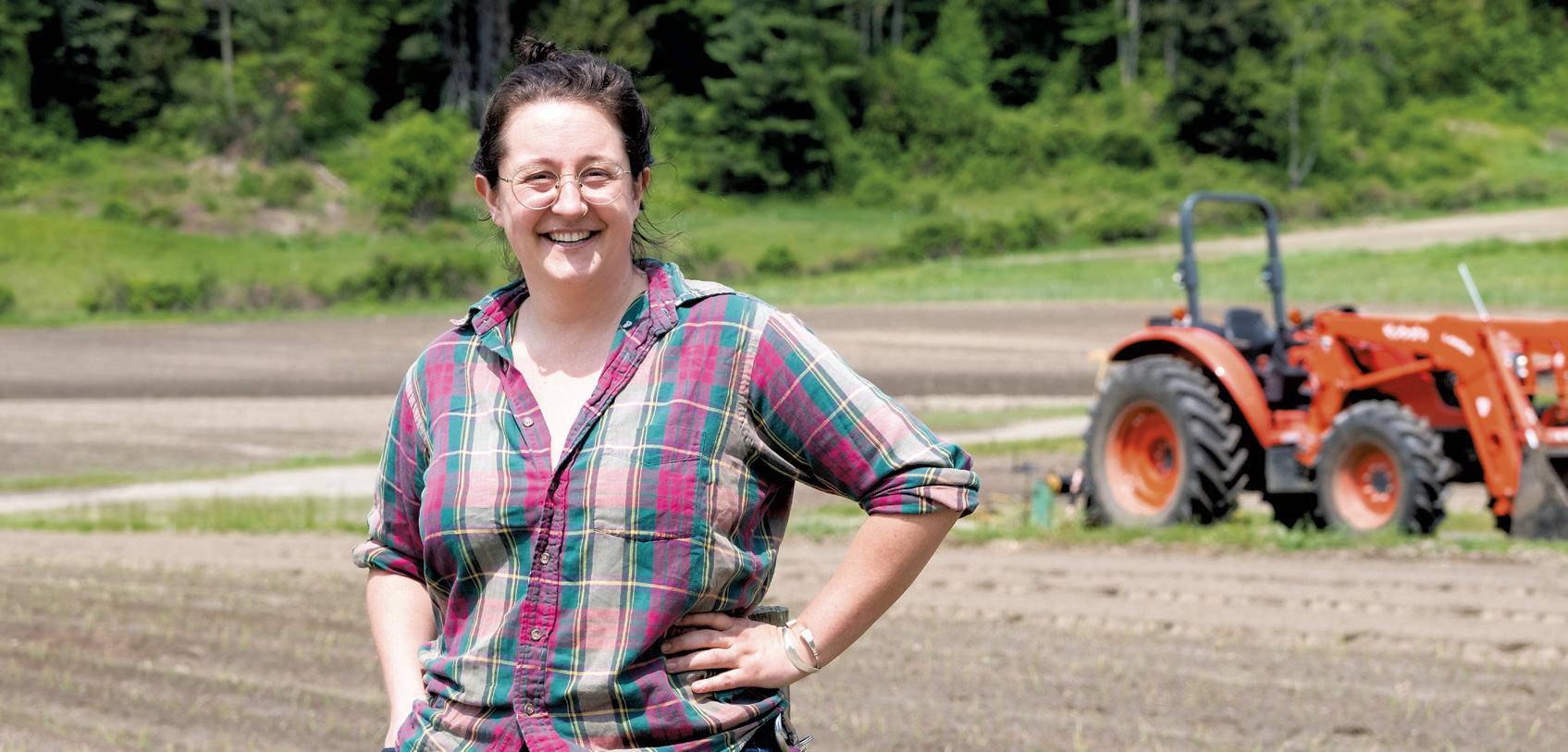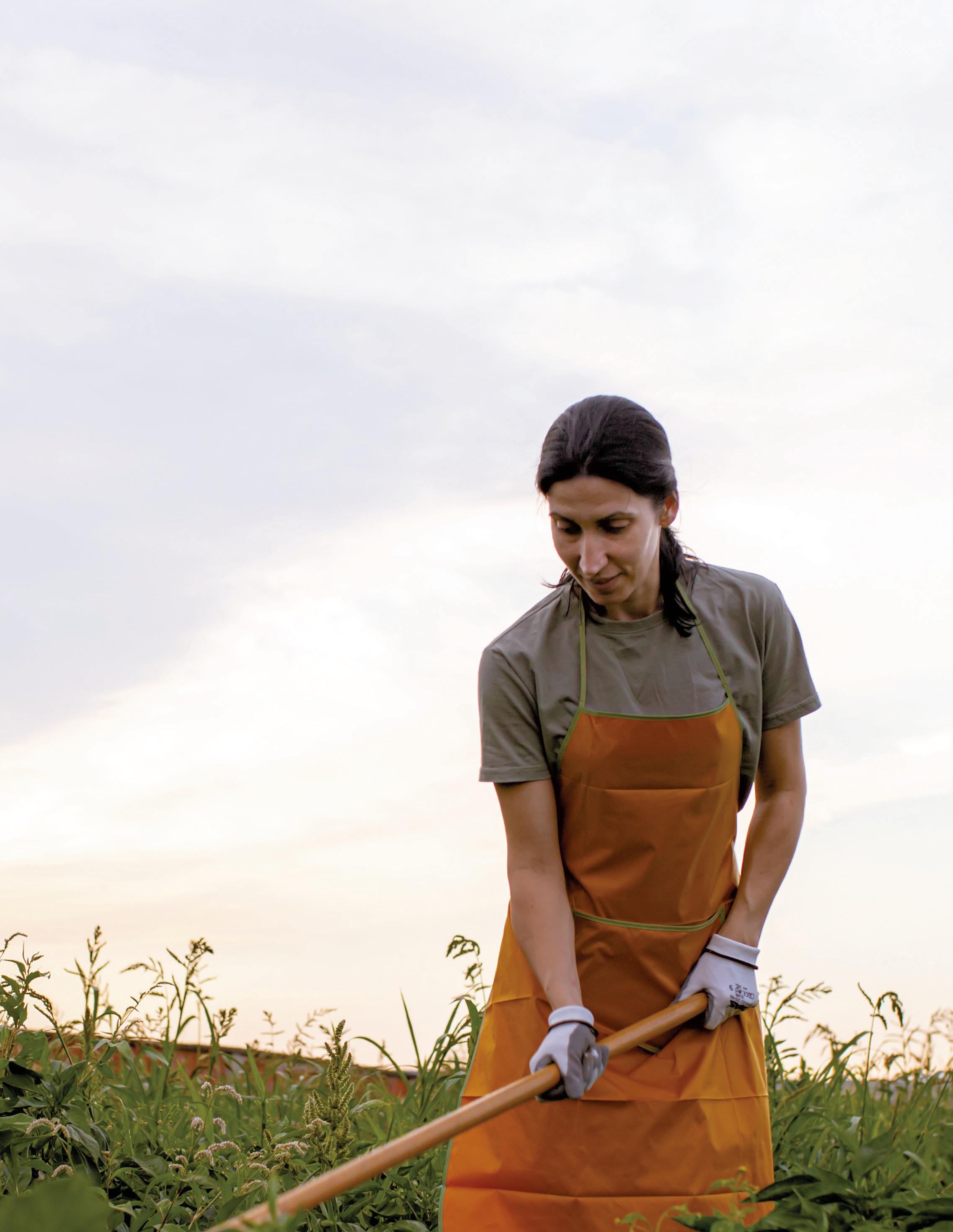Kernels
Summer 2023

INSIDE THIS EDITION
Field to Plate: Local Food for All Vermont Neighbors
Sharing Food, Showing Love
vtfoodbank.org
Big Heart in a Little Town
Building More
Inclusive
Community with Local Food

Summer 2023

Field to Plate: Local Food for All Vermont Neighbors
Sharing Food, Showing Love
vtfoodbank.org
Big Heart in a Little Town
Building More
Inclusive
Community with Local Food

Late summer is a special time in Vermont. Even as farms and families continue to recover from devastating floods, crops are ripening and the squash, onions, and carrots are growing plump in anticipation of the fall. Farmers markets and backyard gardens are offering up fresh colors and tastes.
Thanks to your help, the Foodbank has been able to continue to support local farms after the floods and share as much of this year’s harvest among our neighbors as we can. Gleaning volunteers are out harvesting excess produce donated by generous partner farms and home gardeners can share their extras too, through local food shelves or meal sites (find locations and contact info on vtfoodbank.org).
Those same food sites are purchasing food directly from Vermont farmers through the Foodbank’s Vermonters Feeding Vermonters program, bringing the local bounty to all while sustaining and growing our food economy. And more neighbors are able to enjoy food they know and
love, through home delivery of culturally relevant local veggies. Don’t forget, 3SquaresVT dollars can be spent at many farmers markets, too. This summer has been especially hard for local farms and families, but coming together as a community has helped neighbors across the state continue to access foods they want and need.
I hope you enjoy this edition of Kernels. Please know, the stories here were gathered and written prior to the July floods. Many of the people and places mentioned have faced major challenges—as have so many neighbors statewide. I hope these stories inspire you to pick up some fresh, local ingredients, join your neighbors for a harvest or meal, and make a gift so that everyone in Vermont can enjoy the glorious tastes of summer.
John Sayles CEO
Lots of us dig playing in the dirt here in Vermont. Gardening is a way of life in the Green Mountains. For Talia, a gleaning volunteer, it’s so much more. It’s about connecting with community, grounding herself, and showing love for others through the sharing of food.
“It’s nourishment, but it’s not just caloric-value nourishment, it’s nourishment on so many other levels,” Talia says. “There’s this extension of that nourishment and I think there’s something so grounded and communicative about food, right? We all need food, we all need food every day.”
Looking out over the fields at Harlow Farm, a gleaning partner in Westminster, Talia says she began gleaning with the Foodbank during the pandemic to connect with others and ground herself. Making connections through food with friends, family, and her community has been a lifelong pursuit for Talia. She’s worked with Food Not Bombs, farmed, baked, and gleaned in five states over the years. While the experiences differ slightly, the common thread for her is clear: it’s about love.

local connections and impact that result from gleaning farm fields close to home.
“I’m very much a person who shows their love and appreciation for people through food,” Talia says. “There’s something really beautiful about [gleaning], to not only make food and share it with my friends and family, but also to be able to kind of go to the source…and help extend that food outwards to more people.”
Volunteering has given her a better understanding of food rescue on a large scale—the Foodbank gleans at farms all over Vermont, rescuing surplus produce from fields and distributing it statewide, with your support—but Talia says she appreciates the
“And it’s also a very cool way to kind of get to know the area through a different lens, just knowing which [food shelves] are these going to, which partners of the Foodbank is this going to,” she says.
Ultimately, the sharing of food, loving one’s community, and being part of a system that supports it, is deeply rooted in one thing for Talia.
“Everyone deserves food,” she says. “Everyone deserves to eat, full stop, no questions asked.”
Westminster
At the Fairfield food shelf, neighbors are supporting one another through purchasing and distributing food grown within their own community. Thanks to a Foodbank grant program, and supporters like you, community members experiencing hunger can enjoy more local food grown by their neighbors.
At the Fairfield Community Center Association (FCCA) food shelf, Julie is cleaning leeks. Pat prepares vibrant vegetable displays in baskets, and Megan is chatting with guests. A neighbor stops in to donate several dozen eggs from their own chickens. “People have a lot of heart, who live here,” says Megan. “And you get to know everybody!”
FCCA does a lot when it comes to food: an outdoor pizza oven fires up for dinners that help fund the center; community lunch is served on Tuesdays; food bags are packed and delivered weekly to migrant farmworkers and older housebound neighbors; there are raised beds of veggies for pizza toppings and food shelf samples. “Food is love,” states Pat. “It’s a great way of connecting.”
And there’s a special focus on local food. In an area that produces a lot of food, neighbors often deliver extras from their farms and gardens to the food shelf. Everything from hydroponic lettuce, to rhubarb, to goose eggs.
FCCA also purchases Vermont-grown produce and dairy through Vermont Foodbank’s Vermonters Feeding Vermonters (VFV) Mini-Grants program—supported by friends like you—which offers funding for partners to buy directly from local farmers. By encouraging charitable food sites statewide to buy and distribute more Vermont products, this program helps expand local food access to more neighbors, provide security for farmers, strengthen the Vermont economy, and reduce environmental impact.
Whole milk from Monument Farms Dairy is one item they purchase consistently, so food shelf guests can count on its availability. Mostly, FCCA uses their VFV grants to buy from small family farms down the road, and homesteading neighbors.
“We have relationships with a number of farms that let us know when they have extra produce. Two farms in particular, Stone Hollow and Cat’s Meow…And [we] offer to buy seconds of high-end cheese producers, trying to give them a market for those products. In particular, Stony Pond Farm… Otherwise it’s just been miscellaneous vegetables that [community members] have grown,” explains Julie. “For homesteaders, it’s really a benefit to them, to have a little bit of income from the extra produce they grow. And it also gives us a lot more variety. You know if we were dealing with a big farm, we might just get two or three products.”
Beets, carrots, apples, and other storage crops are some of people’s favorite local items to get at the food shelf, as well as spinach, eggs, and whole milk. “People are very happy,” says Pat. “We get good feedback.”
“We’ve definitely seen an increase of need,” explains Megan. “The last few years, the way everything’s going with inflation and everyone struggling to make ends meet, these kinds of places are really important to have.
“Besides the food that we provide, which is of course paramount in these times, people have also been starved for social interaction. And that’s what a lot of this is here…People will come to hang out and to talk…Everyone knows each other’s names…Everyone is from the community. It’s all your neighbors, people that you know and that you respect. A lot of
the volunteers are also clients, so they’ll come get their food box and their produce. It’s just the way it works.”
Visiting the Fairfield Community Center is a lesson in the ecosystem of community, and the cyclical nature of mutual support. And how, especially in a place like Vermont, sharing local food with neighbors facing hunger has an impact that ripples out.

You’re bringing more local food to neighbors facing hunger, while supporting the neighbors who grow it.
“I think those relationships are important, with the farmers,” shares Julie. “They come to support the community center, with other programs that we’re putting on. And it really is a way to build community, to grow community.
“I think it’s just good for the clients to know that their needs are being supported by farms, locally, too. And the taste. I mean, and the taste.”
FairfieldVermont relies on migrant workers to sustain the state’s agricultural industry. But it can be difficult for farmworkers to find and afford the types of food they enjoy and are used to. With help from community partnerships, and help from you, culturally relevant produce is being delivered directly to migrant farmworker households.
“I’m new here in the United States,” says Isabel*. “I didn’t know what the system was. I didn’t even know where things were. So, since [food is delivered] to our house and it is things we recognize, it makes it much easier. And besides that, with that help, well, one feels supported and accepted in the community.”
Isabel has been living in Vermont with her family for nearly three years and receives Vermont-grown, culturally relevant produce through a Vermont Foodbank CSA project— that you help support—that provides CSA shares to migrant farmworker households in Addison County and the Northeast Kingdom.
The Foodbank purchases produce from local farms that agree to grow favorite, familiar vegetables requested by recipients. The food is then delivered directly to where people live, thanks to partnerships with local organizations such as Champlain Valley Office of Economic Opportunity, July through November.
“I really like that as part of the program [you] bring us cilantro, tomato, onion. I love it because the
garlic is also very fresh…Also the epazote…Yes, there are many things that are actually quite good. And yes, I always use them,” says Isabel.
“On the occasions I have been here, [the delivery person] is always very friendly and he tries to explain to me what kind of each vegetable is grown which place…I don’t speak English and he doesn’t speak Spanish either, but we talk. It’s something nice and it’s inexplicable because we understand each other even though we don’t speak the same languages.
“There is nothing to be ashamed or embarrassed about. It is a safe way [to get support].”

* Isabel is a pseudonym. This interview was conducted in Spanish by Julissa Vesely, a community health worker who helps coordinate migrant farmworker participation in the Vermont Foodbank CSA project and translated by her colleague Naomi, from Migrant Health Programs with UVM Extension—thank you! Photo substituted to protect identity.
Home delivery of preferred foods to migrant worker households is meaningful for many reasons. Low wages and work permit rules make it difficult to afford nourishing food—especially fresh, local produce. Lack of transportation, long hours, and concern for personal safety can make it challenging to go to the grocery store. And it can be hard for people to find the types of foods they are used to cooking and eating.
“The truth, yes. It is really difficult for us to find the vegetables necessary and adequate to give a touch of flavor from my country to the food,” explains Isabel. “Last year, I remember that the gentleman came to leave me my vegetables and I was surprised because he brought me jicama. And he told me that these were cultivated here! I felt good, so happy, because it is a fruit that is very rare to find here. And he brought it to me! And then my daughters and I made jicama with a little salt, lime, tajín, and we were so happy. So the program also helps to bring us a little bit of our thing to Vermont, to our house.”
Beyond supporting neighbors’ physical and nutritional needs, ensuring access to foods people know and love is also a way to tend to one another’s emotional well-being.
“Look, it has a very positive impact,” Isabel shares. “In the first place, because there is a direct relationship with being able to save a little. Secondly, because these vegetables, as I mentioned, are fresh and I can use all of them because I have the cooking experience.
“And it’s the motivation for another smile every Wednesday or Thursday that the [delivery] comes, as we are always waiting for the bag of vegetables to see what is included this week. It is positive, the impact it has had. It helps us a lot.”
Together, we can create communities more welcoming and inclusive for everyone who lives here. Let’s continue working toward a Vermont where everyone has equitable access to enough nourishing food every day.

You’re helping build community by making sure neighbors have nourishing food they know and love.

This time of year is full of bounty—sweet corn, watermelon, and tomatoes are all ripening and appearing at picnics and on dinner tables. It’s also a reminder of the devastating floods that affected so many local farms and neighbors across Vermont this summer. Recovery continues, and for many people household budgets are strained by ongoing increases in food, fuel, and housing costs. Neighbors across the state have shared that affording fresh and local foods can be especially hard.
“People do not eat the nutritious food that they need to eat to stay out of the hospital because we can’t afford to do it. That’s the dog chasing its tail,” a community member explained recently.
Vermont Foodbank continues to prioritize making fresh and local foods accessible to neighbors facing hunger across the state, but we can’t do it alone. In 2022, more than 60%
of the food Vermont Foodbank shared with the community was fresh foods, including food from more than 300 Vermont farms. We need your help to continue prioritizing the purchase, gleaning, and distribution of fresh foods—from eggs to corn, to local dairy products and berries.
A gift of $35 helps provide a household with $145 worth of groceries, connecting neighbors with nourishing food when they need it.
Together, we can help make sure that the foods people need and want are available to fill tables and provide nourishing meals all year long.
If you or someone you know could use help accessing food, please be in touch. Our contact information is below, and our website is available in eight languages common to Vermont.